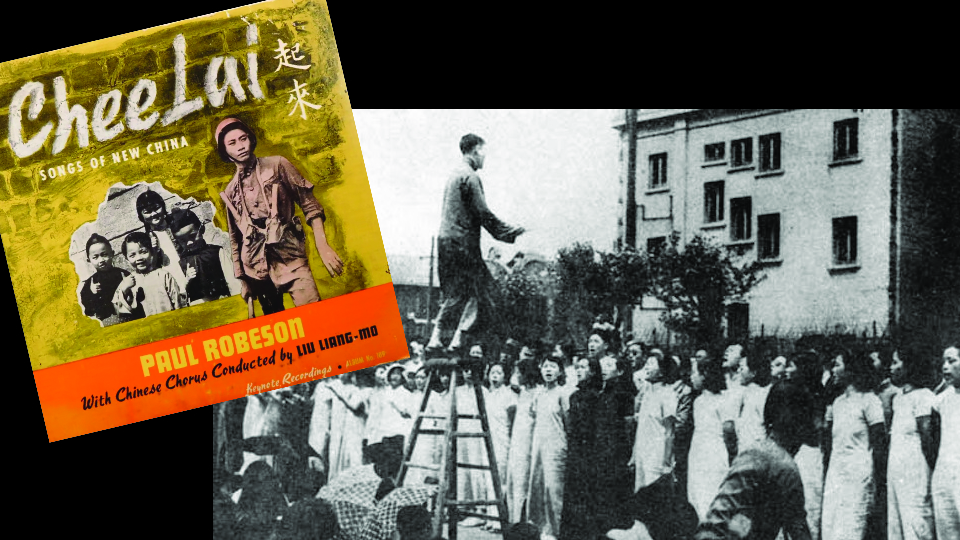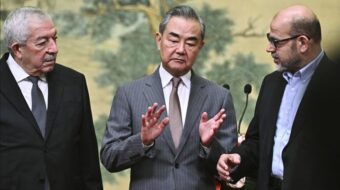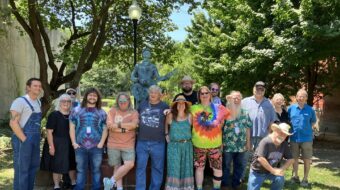
When the slender, affable Chinese man took the podium in Harlem’s posh Golden Gate ballroom on a late autumn afternoon to denounce three recent lynchings in Mississippi, the audience’s FBI informant perked up. Liu Liangmo, a public speaker employed by United China Relief, a non-partisan charity that raised funds to aid China during a brutal Japanese invasion, proceeded to denounce racism as a system: lynchings, poll taxes, and Jim Crow apartheid. He highlighted white supremacy’s links to fascism and imperialism and called for equality and self-determination for all peoples. The bespectacled Liu took his seat to the applause of several hundred at an event sponsored by the Negro Labor Victory Committee, the Negro Quarterly, and the actor Orson Welles. As a professional public speaker, Liu’s task was to promote a deeper understanding of China to American audiences. In the age before television, public speaking events were among the most important ways an organization that couldn’t afford to make a movie or publish a newspaper could share its ideas. In his nine years in the U.S., Liu believed he had traveled 100,000 miles across most of the country.
Historian Gao Yunxiang is a Professor of History at Ryerson University in Toronto. In this original and well-researched book, Arise Africa! Roar, China!: Black and Chinese Citizens of the World in the Twentieth Century, she documents the experiences of five individuals—W.E.B. Du Bois, Paul Robeson, Liu Liangmo, Si-lan Chen Leyda, and Langston Hughes—through the lens of their relations to China, with African America, racism, U.S. government persecution, and anti-imperialist working-class struggles for freedom. Liu, persecuted by the FBI and the immigration regime, left the U.S. in 1949 to serve as a leader of the Chinese Democratic League, one of the several non-communist parties that continues to serve in the country’s National People’s Political Consultative Conference. He also helped to mobilize the Chinese Christian community in support of resistance to Japanese occupation and the ultimate revolutionary transformation of the country.

Through the translation of contemporary Chinese media sources, Gao provides new insights into the 1959 and 1962 visits of W.E.B. Du Bois and Shirley Graham Du Bois to China. Gao insightfully details how Du Bois’s consistent Pan-Africanism and anti-racism led him to express support for Tokyo in the late 1930s. While he conceded Japanese atrocities in China and Korea, he refused to accept that U.S. carnages in Asia since the 1890s could be excused as part of its “civilizing” project.
Delving into both U.S. archives and Chinese media accounts, Gao’s intensive study reveals how politics in China shaped Du Bois’s perception of that country. He dismissed Chiang Kai-shek, then the anti-Communist leader of the Nationalist Party, as a “Chinese Uncle Tom” for accepting U.S. hegemony and targeting revolutionary forces for his strongest military attacks. The Japanese Empire represented a better choice for Asian leadership and signaled the decline of white supremacy and Western imperialism, Du Bois had concluded, even if mistakenly. By the early 1940s, however, Du Bois’s position had significantly shifted. The communist-led surge against Japan, the Soviet alliance with China, and the swelling anti-colonial possibilities after the war pushed Du Bois’s views to shift in favor of revolutionary China. Ultimately, Du Bois would condemn U.S. support for the Nationalist rule of Taiwan island, calling for an end to sending arms to fuel its separatist intentions.
Gao shows that despite nearly eight years of government persecution, prosecution, and harassment during the McCarthy era, Du Bois finally was able to leave the country, travel to the Soviet Union (among numerous other European countries), and then to China. Even as the U.S. claimed yet another illegal war in the name of democracy, it suppressed, censored, imprisoned, and persecuted those who criticized the militarism and systemic inequalities it deployed and protected. In China, Du Bois and Shirley Graham Du Bois met with major political and intellectual leaders of the country. They traveled for eight weeks, visiting several provinces, many major cities, several small towns, collective farms, universities, factories, and scientific facilities. Du Bois later wrote, “We saw the planning of a nation and a system of work rising over the entrails of a dead empire.”
Although Paul Robeson never visited China, his love for that country sparkled in his writings, speeches, and conversations with journalists. Similarly hounded and mistreated by the U.S. government because of his political ideas, Robeson befriended Chinese intellectuals, artists, and activists. He had met and worked with Liu Liangmo, who taught him the words to “Chee Lai,” the Americanized title of the song “March of the Volunteers,” which became the People’s Republic’s national anthem in 1949. As an organizer for the YMCA in Shanghai and other Chinese cities in the 1930s, Liu invented and spread the concept of “mass singing.” He taught large groups of Chinese people to sing patriotic and revolutionary songs. He worked for the Communist-led anti-occupation army before heading to the U.S. for his role here. Liu had not written “March of the Volunteers,” but his mass singing work had made it popular among millions of people during the war against Japan.

Robeson’s friendship with Liu and his use of the song deepened the great artist’s ties to China. Its first line—“Arise! ye who refuse to be bond slaves!”—struck a chord with Robeson. In his mind, it spoke to a strong union among people of African descent, African countries, and revolutionary China. Despite being trapped by the U.S. government which confiscated his passport, Robeson celebrated the People’s Republic on its third anniversary in 1952 with an article in Freedom titled “Happy Birthday, New China.” In it he wrote, “With China free and Africa rising against the rule of White Supremacy, I look forward to a new flowering of those two great ancient cultures, bringing to all mankind riches in the arts and science.” Robeson consistently denounced the current U.S. war in Korea. Gao argues that Robeson’s commitment to China remained strong even after events in the 1960s forged a split between it and the Soviet Union, though his support was much more muted.
Gao’s final two chapters study the lives of Afro-Chinese dancer Sylvia Si-lan Chen Leyda and famed poet Langston Hughes. Chen was the daughter of diplomat Eugene Chen, who had lived in Trinidad. In the 1920s, he returned to the Republic of China with his children to aid diplomatic efforts during its early struggles for independence. Despite gaining a strong reputation, his anti-imperialist commitments led to a falling out with Chiang Kai-shek during his 1927 power grab.
The whole Chen family, along with Madame Sun Yat-sen, fled to the Soviet Union. There, as a young adult, Sylvia Chen developed her dance style and theoretical approach to the art. She learned to craft visual representations of Chinese (and of many peoples of color) struggles against Western racism and imperialism. She met Langston Hughes during his 1932-33 Moscow trip, and Hughes would later describe their relationship in romantic terms. Gao traces much of their personal relationship through the letters Sylvia preserved in her papers, even many years after her marriage to the U.S. filmmaker Jay Leyda.
Despite her marriage to a citizen, Sylvia’s sojourn in the U.S. was troubled by FBI and immigration harassment, often aided by Nationalist informants living in the U.S. Citing the Chinese Exclusion Act, immigration officials denied her the right to hold a job. Consequently, most of her work involved charitable engagements with dance and artistic societies, as well as speaking engagements at which she denounced racism, imperialism, and U.S. interventions in Korea and threats of intervention in China, up to and including its planned use of the A-bomb. Chen continued to dance, accompanied on occasion by Huddie “Lead Belly” Ledbetter and Duke Ellington. Interactions with African-American radicals deepened her anti-racist commitments and seasoned her speeches and performances.

After six months in the Soviet Union, perhaps inspired by both his politics and his affair with Sylvia Chen, Langston Hughes made his way home via Japan and then Shanghai. Upon his arrival in Shanghai, he was met by several intellectuals and journalists who interviewed him extensively about radical literature, African-American culture, and his impressions of China. Gao provides a detailed discussion of Chinese scholarly analysis of Hughes’s evolution as a poet and writer of realistic fiction over this early part of his career. They had closely studied many of his essays, poems, short stories, and novels, some of which they published in translation to celebrate his visit.
According to Gao, Hughes differed from most Western visitors by refusing to stay within the racist cocoon that comprised the international concession zone in the city. He ate street food, enjoyed Chinese theater, and interacted with working-class Chinese people like humans. While these activities may seem normal today, at the time they set him apart from Euro-Americans who spread racist stereotypes about Chinese people, enforced Jim Crow rules, and typically viewed Chinese people as diseased, dangerous, and untrustworthy. Hughes’s experience in China, along with his political support for the revolutionary struggle, impacted his poetry, novels, and short stories over the next decade or so. In a second stopover in Tokyo after his brief time in Shanghai, Hughes was detained extensively by the police, treating him like a criminal.
Arise, Africa! Roar, China! is an important contribution to scholarship on the Communist Party and related social movements in the mid-20th century. It offers whole new perspectives on important U.S. radicals, with new details culled from Chinese-language media sources. It gives new insights into the interactions and political relationships of revolutionary Chinese and African-American intellectuals, pointing frequently to new connections across cultures and languages that deserve even more scholarly scrutiny. Occasional diversions from the main narrative frame, chronological diversions, and editorial lapses are noticeable but do not fundamentally undermine the overall success of this important book.
Gao Yunxiang
Arise, Africa! Roar, China!: Black and Chinese Citizens of the World in the Twentieth Century
University of North Carolina Press, 2021
408 pp.
HARDCOVER ISBN: 978-1-4696-6460-6
Ebook ISBN: 978-1-4696-6461-3
We hope you appreciated this article. At People’s World, we believe news and information should be free and accessible to all, but we need your help. Our journalism is free of corporate influence and paywalls because we are totally reader-supported. Only you, our readers and supporters, make this possible. If you enjoy reading People’s World and the stories we bring you, please support our work by donating or becoming a monthly sustainer today. Thank you!












Comments